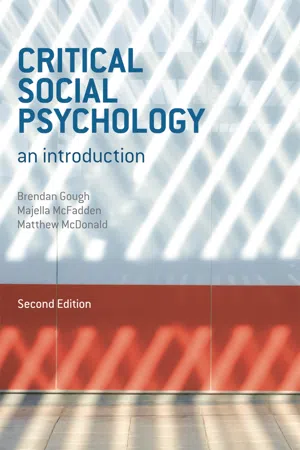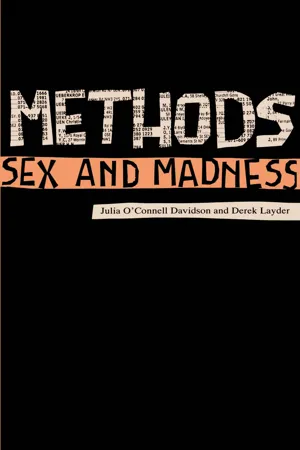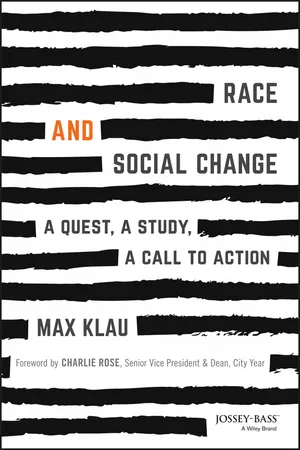Psychology
Classic and Contemporary Research into Obedience
"Classic and Contemporary Research into Obedience" refers to the study of how individuals comply with authority figures. Classic research, such as Stanley Milgram's obedience experiments, demonstrated the powerful influence of authority on behavior. Contemporary research continues to explore factors influencing obedience, including social norms, situational variables, and individual differences. This body of research has contributed to our understanding of human behavior and social influence.
Written by Perlego with AI-assistance
Related key terms
9 Key excerpts on "Classic and Contemporary Research into Obedience"
- eBook - ePub
Great Ideas in Psychology
A Cultural and Historical Introduction
- Fathali Moghaddam(Author)
- 2013(Publication Date)
- Oneworld Publications(Publisher)
2 Imagine living in the seventeenth century rather than the twenty-first century. What are some ways in which you would experience less individual rights and be expected to show greater obedience to authority?THE EXPERIMENTAL STUDY OF OBEDIENCE
Before 1960, two ground-breaking series of studies on conformity were conducted by psychologists, the first initiated by Muzafer Sherif in the 1930s and the second by Solomon Asch in the 1950s. Both of these series of studies were conducted in contexts involving issues that had little real-world significance: estimating the movement of a spot of light (in the case of Sherif’s studies) and estimating lengths of lines (in the case of Asch’s studies). During 1959–60 Stanley Milgram was working in Asch’s laboratory and thinking about what would happen if instead of the movement of a spot of light, judgments of line lengths, or the like, issues of greater human significance were introduced into the laboratory. Would the individual still bend to the will of the majority? This question was the point of departure for Milgram’s studies on obedience to authority, and it eventually led to the question of how far individuals would obey an authority figure.Milgram recruited participants by advertising for volunteers aged 20–50 to take part in a study on the effect of punishment on learning. Participants were told that a goal of the research was to discover how much punishment is good for learning, how much difference it makes whether an older or younger person is giving the punishment, and similar such questions. From the pool of applicants he was able to select a sample of participants with varied ages and backgrounds. In each experiment, the participants were forty percent skilled and unskilled workers, forty percent white-collar, sales, and business, and twenty percent professionals. All those selected had been screened to ensure that they had a normal psychological profile. When the selected participants arrived at Milgram’s laboratory, they were introduced to another person who was supposedly also a participant but was actually a middle-aged accountant selected to act as Milgram’s confederate. It was explained to the participants that this learning experiment required a teacher and a student. The two participants drew lots to decide who would play the role of the teacher and who would play the role of the student, but the outcome was pre-arranged so that the confederate would always play the role of student. There was also a scientist in a white laboratory coat in the room, purportedly in charge of the “learning study.” - eBook - ePub
Critical Social Psychology
An Introduction
- Brendan Gough, Majella McFadden, Matthew McDonald(Authors)
- 2013(Publication Date)
- Bloomsbury Academic(Publisher)
Events witnessed during the Second World War raised new questions about how others can influence the behaviour of the individual. In particular, the concept of obedience took centre-stage, embodied in Milgram’s (1974) empirical studies into the psychological mechanisms underlying obedience. Milgram advertised for volunteers to participate in a study at Yale University on the effects of punishment on learning. Over one thousand volunteers were to perform either as teacher or pupil, roles that were assigned randomly. ‘Teachers’ were to aid learning by giving electric shocks of increasing voltage each time ‘pupils’, situated in a separate room, answered incorrectly. Voltage levers were labelled from mild up to 450 volts (Danger: Severe shock), and teachers were instructed to progress with shocks by the experimenter standing beside them. The disturbing findings showed 62 per cent of the teachers inflicting shocks to the maximum voltage, despite their own discomfort and the cries of pain coming from pupils.Explanations for why people were prepared to unexpectedly shock other people to 450 volts centred on the pervasiveness of social power and status; that, in the presence of authority figures, individuals lose their capacity for rational, moral thinking and succumb to the authority of the powerful ‘other’. Milgram illustrated that obedience is related to situational pressure, a finding that was extremely novel for psychology in the 1960s, as previous explanations of destructive obedience had centred on character traits and certain types of people (e.g. ‘The Germans are different’ hypothesis).Common themes in classic social psychologyAlthough Le Bon’s (1895) work could be described as a naturalistic inquiry, and that of Sherif, Asch and Milgram as experiments, they share a number of common themes. Firstly, the focus of this work was on the power of one or more persons to change and shape individual behaviour. For Le Bon, observations made during the French Revolution, and for Milgram the events of the Second World War, narrowed the focus further to concentrate on the presumed negative influence that others could have on the behaviour of the individual. Secondly, each shared a vision of the individual in his (or her) natural state of existence, that of the rational moral being existing separately from an objective social world. Finally, each shared similar epistemological origins: the classic works are, as Stainton-Rogers et al. - eBook - ePub
- Dr Derek Layder, Julia O'Connell Davidson(Authors)
- 2012(Publication Date)
- Routledge(Publisher)
Positivist methodologists hold that, as with natural science experiments, the key to good design is to ensure that the effects of the independent variable are isolated from other conditions. It would be no good, for instance, to re-measure subject’s attitudes towards rape several days after they had been exposed to the video material, since the experimenter would not be able to tell whether it was exposure to the video that had affected their attitudes, or exposure to some other variable(s) in the interim period. A number of studies in this vein have been conducted (particularly by Malamuth, see for example Malamuth 1986) and the findings widely used in the feminist anti-pornography campaign. For an excellent feminist critique of both these experiments and the feminist anti-pornography literature which relies so heavily upon them, see King (1993).Social scientific laboratory research does not always entail using the experimental method or hypothesis testing. It can simply involve observation. Psychologists have, for example, investigated various forms of human interaction, such as non-verbal communication, simply by observing subjects interacting in the laboratory through one-way mirrors. What both these forms of laboratory research have in common is a very particular kind of observation, namely observation that is structured and controlled along the same lines as observation in the natural sciences. One of the recurrent themes of this book is the idea that attempts to replicate the methods of the natural sciences in the study of the social world are highly problematic, and the following sections reiterate this point through a focus on some of the ethical and philosophical issues raised by a classic social psychology experiment.MILGRAM’S EXPERIMENTAL RESEARCH ON OBEDIENCE: ETHICS AND INTERPRETATION
Milgram’s (1963) experimental study of obedience is well known. He wanted to investigate the extent to which ordinary people would be prepared to obey an authority figure. Would they be willing to inflict pain on others if commanded to do so, or would their own moral and normative values lead them to resist such instructions? His subjects were deceived into believing they were taking part in a learning study. They were asked to sit in a cubicle, next door to a ‘student’, and told that the control panel in front of them would allow them to administer increasingly severe electric shocks to that student if he or she gave the wrong answers to questions. When the ficticious shocks were administered, the subject heard cries and screams from the ‘student’ through the partition walls: - eBook - ePub
- Alan Berkeley Thomas(Author)
- 2004(Publication Date)
- Routledge(Publisher)
If codes of ethics give the impression of being rather half-hearted, this may be because they have been produced less from moral conviction than from professional expediency (Homan, 1991). At worst they might be seen as public relations exercises which give the appearance of ethical propriety to research while actually ruling little or nothing out. More charitably, it is often the case that ethical problems in social research are complex and that there is no consensus among professionals about appropriate courses of action. If, as some philosophers have argued, right conduct cannot be guaranteed by following general moral rules but is situationally determined, it is no wonder that the professional associations’ ethics committees have so much difficulty in formulating clear-cut codes of practice for social and management research.A case study in research ethics: Milgram’s research on obedience to authority
One of the best-known examples of social research to have given rise to ethical controversy is that carried out in the 1960s by the American psychologist Stanley Milgram at Yale University. His work has been variously described as ‘classic’, ‘famous’, ‘controversial’ and ‘notorious’ (Miller, 1986).Milgram conducted a series of experiments that were intended to illuminate the processes associated with obedience to authority. In part these studies were motivated by a desire to understand the kind of behaviour which resulted in the systematic extermination of millions of people in the Nazi death-camps during the Second World War. This activity required the obedience of ‘ordinary people’ to the murderous commands of their superiors. Milgram (1963, p. 371) described the project as follows:This article describes a procedure for the study of destructive obedience in the laboratory. It consists of ordering a naïve S[ubject] to administer increasingly severe punishment to a victim in the context of a learning experiment. Punishment is administered by means of a shock generator with 30 graded switches ranging from Slight Shock to Danger: Severe Shock. The victim is a confederate of the E[xperimenter]. The primary dependent variable is the maximum shock the S is willing to administer before he refuses to continue further. - Susanne C. Knittel, Zachary J. Goldberg(Authors)
- 2019(Publication Date)
- Routledge(Publisher)
The ongoing fascination with Milgram’s studies can be seen to arise from the use of laboratory experimentation to provide a dramatic and powerful illustration of the way in which people might respond to the demands of authority. The initial controversy generated by the experiments has shown little sign of abating and if anything has intensified in recent years. Nevertheless, the received view of the obedience experiments remains dominant in textbook accounts and makes the continued attempts to develop new perspectives on Milgram’s work all the more important. Indeed, there are signs that these new perspectives are now crystallizing themselves into a key message concerning the wider implications for our understanding of the experiments and of the concept of obedience itself.Perhaps the most important change in the way in which we now think about Milgram’s experiments concerns the nature of obedience and the extent to which Milgram’s studies can be said to stand as examples of this phenomenon. We have become so used to referring to the studies as “the obedience experiments” that perhaps we have failed to consider whether they really are demonstrations of obedience at all. A number of scholars from a variety of conceptual and methodological traditions have noted that the scripted prods are not particularly effective at eliciting more shocks from participants anyway (Burger et al. 2011; Gibson 2013a; Haslam et al. 2014), which leads to questions as to whether Milgram’s experiments are in fact demonstrations of people following orders at all. Moreover, given that social psychologists tend to define obedience as a form of social influence elicited in response to orders/commands (e.g., Burger 2017; Kassin et al. 2017), there is a legitimate question mark over whether Milgram’s “obedience” experiments are in fact studies of obedience.However, this would be to accept uncritically the standard definition of obedience. Instead, we might be wise to reflect on whether this definition has ever really been adequate. The requirement that the specific social act of an order or command be observed before we can classify something as obedience seems overly restrictive. In everyday life, when we refer to obeying the law, we are not typically describing situations in which we are under direct orders from an authority figure. Rather, we “obey” by observing social norms that proscribe certain actions. More formally, we might draw on the influential work of the social theorist Michel Foucault (1979), who noted that authority in modern liberal societies is rarely exercised bluntly. Instead, obedience is elicited through more subtle means and indeed is most effective when people come to regulate their own behaviors. We might, therefore, suggest a revised definition of obedience as simply submission to the requirements of authority (Gibson 2019b). These requirements might be stated explicitly in the form of an order, but they need not be. Indeed, when we return to the audio recordings of Milgram’s experimental sessions, we find that not only are participants able to resist the experimenter’s increasingly strident demands that they continue, but those participants who do go all the way to the end of the procedure typically do so without the need for the experimenter to use the prods (Gibson 2019a, 2019b). We are thus left with the conclusion that this hugely influential and controversial set of studies does not stand as a demonstration of people’s propensity to follow orders. Rather, it shows us that when participants are obedient, it is not because they have been issued with orders, and when orders are issued participants are able to resist them. The experiments thus can no longer be used to warrant claims about perpetrator behavior arising because of people following orders. If they tell us anything, it is that perpetrators are—as numerous scholars have noted (e.g., Bauman 1989)—part of a wider system. If this system “works,” no direct orders are needed. In Milgram’s study, the experimenter only had to resort to issuing orders when the experimental set-up had failed to do its job in convincing people to keep going. We can still identify those who continued as having been obedient, but this did not mean that they followed orders. The authority of Milgram’s obedience situation lay elsewhere in its design and execution. If the experimenter had to resort to orders, it was not, in fact, a demonstration of authority but rather an indication of its failure- eBook - ePub
Stanley Milgram
Understanding Obedience and its Implications
- Peter Lunt(Author)
- 2009(Publication Date)
- Bloomsbury Academic(Publisher)
However, the experiments have captured the public imagination beyond the boundaries of academia. Blass (2004) documents how Milgram’s obedience experiments have become part of popular culture reflected in songs such as Peter Gabriel’s ‘We do what we’re told (Milgram’s 37)’ on his album So. Conceptual artist Rod Dickinson presented a detailed stage re-enactment of the Milgram experiments at the Centre for Contemporary Art in Glasgow in 2002. A number of plays have been written inspired by the obedience experiments including Dannie Abse’s play ‘The Dogs of Pavlov’ (Blass, 2004). Like a film or a book, Milgram’s experiment offers a setting and a cast of characters and allows the action to unfold as a narrative offering us the chance to think through general questions of human nature and society. In this chapter I will explore the discussion of Milgram’s findings in writings in the history of psychology, moral theory, sociology and media studies which creates an impression of the manifold interpretations afforded by his research. The intellectual range of these questions also reflects Milgram’s eclecticism. We read Milgram today through the lens of the way that subsequent writers take up, rework, contest and elaborate the underlying questions and concerns in his work. This sharpens the analysis of the assumptions made by Milgram in framing and writing about his research. Conceptions of what counts as critical social science, of individuality and individualism, of the morality of virtue and of the operations of power have all changed significantly since Milgram’s day - eBook - ePub
Intelligent Disobedience
Doing Right When What You're Told to Do Is Wrong
- Ira Chaleff(Author)
- 2015(Publication Date)
- Berrett-Koehler Publishers(Publisher)
I am going to review the research here because it is too important to not be part of the training of successive generations. I don’t just mean professional training, I mean training as citizens of liberal democracies or, even more fundamentally, education as decent human beings. This is a call to those who design civics curricula to include this classic research and to design activities that connect it to the lives of successive waves of those who will occasionally need to intelligently disobey for the good of us all.Dr. Stanley Milgram and Obedience to Authority
First, let’s set the historic stage for what have come to be known as the Milgram experiments conducted between 1960 and 1963.This period is still psychologically the aftermath of the Second World War. I know this personally. When I was a boy growing up in Brooklyn, New York, I played a solitary ball game against the stone steps, or in the local vernacular “stoop,” outside my row home. My personal variation of the game was to have each point I earned represent a Jew saved from the Nazi death camps. In my late teens, in 1964, I hitch-hiked through Serbia, then part of Yugoslavia. The first question I was always asked was “Are you German?” If I was, few would be willing to help me, even fifteen years after the German occupation of the country had ended. One fellow hitchhiker reported a German youth having been stoned by the townsfolk who had lived through the occupation. The larger Western world was still shocked by the reality that Germans, citizens of a highly advanced “civilized” country that brought the world brilliant music, literature, and art, could have obeyed a murderous regime and implemented orders to starve and kill millions of men, women, and children. Photographs of gaunt faces and skeletal bodies continue to haunt the collective psyche to this day, as they should.From 1945 to 1948—well before 1960 when Milgram began his experiments—the victorious allied governments conducted the Nuremberg trials of those accused of war crimes. The trials firmly established the principle that the claim of “just following orders” was not a defense against committing crimes. A series of principles were developed to guide the tribunals. The one germane to our discussion is Principle IV. - eBook - ePub
Psychoanalysis, Classic Social Psychology and Moral Living
Let the Conversation Begin
- Paul Marcus(Author)
- 2019(Publication Date)
- Routledge(Publisher)
Social psychologist Muzafer Sherif, who headed the classic Robbers Cave experiment (1961), noted that “Milgram’s obedience experiment is the single greatest contribution to human knowledge ever made by the field of social psychology, perhaps psychology in general” (Reicher & Haslam, 2017, p. 111). If Sherif’s exalted characterization of Milgram’s obedience experiments is plausible, how did Milgram and later researchers explain his deeply troubling findings?By obedience, Milgram meant “the action of the subject who complies with authority,”6 while its cousin term, conformity, as described in the Asch line judgment experiments, refers to “the action of a subjects when he goes along with his peers, people of his own status, who have no special right to direct his behavior” (Milgram, 1974, p. 113).7 There have been mainly two social-psychological explanations of obedience to authority, the one given by Milgram, called the “agentic shift” account (1974), and the other, called the “engaged followership” account (Haslam et al., 2015b). While there have been hundreds of studies investigating Milgram’s experiments, including those that have made methodological advances (Hollander & Maynard, 2016), and those lodged in recent information gathered from Milgram’s personal archive at Yale University (Jetten & Mols, 2014), the challenge of satisfactorily explaining the obedience to authority effect has not been resolved. It has, in part, been used to explain behavior during the Holocaust, the My Lai massacre, Abu Ghraib prisoner abuses, terrorism (Gibson, 2014, p. 436), and other toxic social phenomena.As Milgram describes it, the individual, upon entering the laboratory, becomes integrated into a situation that carries its own psychological momentum and drama. The naïve subject’s struggle is whether to stay engaged in the ugly destructive direction and harm another human being or resolve the struggle by disobeying orders. The naïve subjects, reasons Milgram, have entered into an “agentic state” in which the individual no longer views himself as responsible for his own actions but defines himself as an instrument for carrying out the wishes of others (somewhat like Zimbardo’s deindividuation). The agentic state is not just a replacement term for obedience; rather, it is a “mental organization which enhances the likelihood of obedience” (Milgram, 1974, p. 148). According to Milgram, a major alteration of moral consciousness occurs such that the “person becomes something different from his former self, with new properties not easily traced to his usual personality” (ibid., p. 3). A transformation of moral thinking occurs so that naïve subjects feel more obligated to the Experimenter than they do the Learner/victim they are allegedly painfully shocking. As Milgram puts it, “Although a person acting under authority performs actions that seem to violate standards of conscience, it would not be true to say that he loses his moral sense. Instead, it acquires a radically different focus,” namely, “living up to the expectations that the authority has of him” (ibid., p. 8). Once in this state of agency, certain powerful “binding factors” cement the individual into a role that is not easily reversed. The recurrent nature of the action demanded of the Teacher/naïve subject during the experiment itself creates binding forces. As the Teacher/naïve subject delivers more, increasingly painful shocks, he must seek to justify what he has done. One form of justification is to continue shocking to the highest level on the shock generator. By doing so, the subject reassures himself that what he has done before and what he continues to do now is correct and acceptable. - eBook - ePub
Race and Social Change
A Quest, A Study, A Call to Action
- Max Klau(Author)
- 2017(Publication Date)
- Jossey-Bass(Publisher)
The experimenter responds quickly and decisively. “I'll take responsibility. It is absolutely essential that you continue.”Despite his obvious misgivings, the man continues to ask questions and deliver shocks to the increasingly agitated man off-screen. Eventually, the screams and protests stop, and the shocks bring no response. For all we know, the man off-screen is now either unconscious or dead. But the experimenter continues to insist that the man must continue, and so he does…all the way to the last, highest-voltage switch on the machine.The Individual Level of Analysis: Obedience and Conformity
The scene is from a famous (or more accurately, infamous) series of experiments conducted at Yale University in the 1950s by social psychologist Stanley Milgram. The details of the experimental design are explained in the next section, but for now the important point to note is that Milgram's authority experiments were among the first in a series of provocative social psychology experiments that have become classics in the field. Many of these studies have become widely known far beyond the boundaries of social psychology researchers because they compel us to confront the darker shadows of some of the most basic and universal dimensions of human behavior. Because the Separation Exercise that is the focus of this book builds on and extends this tradition in important ways, a review of these classic experiments provides an invaluable context for the insights and perspective that we'll encounter in the pages ahead.Milgram's Obedience Experiments
Social psychologist Stanley Milgram conducted his famous experiments exploring obedience to authority at Yale University in the 1950s. Deeply disturbed by the Nazi genocide of Jews during the recently completed Second World War, Milgram (1974) wanted to understand how ordinary individuals could participate in mass cruelty and violence:
Learn about this page
Index pages curate the most relevant extracts from our library of academic textbooks. They’ve been created using an in-house natural language model (NLM), each adding context and meaning to key research topics.








